Tim Kennedy & Stephen Fallon
HISTORY HISTORY HISTORY HISTORY The Ultimate Revision Book JUNIOR CYCLE SUCCESSSAMPLE
HISTORY
Published by 4schools
89F Lagan Road, Dublin Industrial Estate, Glasnevin, Dublin 11, D11 F98N, Republic of Ireland. T: ++ 353 1 8081494 - F: ++ 353 1 836 2739 - E: info@4schools.ie © 2022
ISBN 978-1-907330-47-6
All rights reserved. No part of this publication may be reproduced or transmitted in any form or by any means, including photocopying and recording, without the publisher’s written permission. Such written permission must also be obtained before any part of this publication is stored in a retrieval system of any nature. Permission requests should be directed to 4schools, 89F Lagan Road, Dublin Industrial Estate, Glasnevin, Dublin 11, D11 F98N, Republic of Ireland. or info@4schools.ie 4schools has attempted to contact all proprietors of images, texts and graphics included in this book. Proprietors we could not reach are requested to contact us.
E-BOOK How to claim and access your e-Book
To claim your e-Book
1. Log in to 4schools.examcraftgroup.ie/user/login
2. Activate your e-Book using the code above at 4schools.examcraftgroup.ie/activatecode
3. Download the app at 4schools.examcraftgroup.ie/apps
4. Log in to the app (please use the same login and password you used on the 4Schools website)
5. Download the e-Book
Notes
Code: SAMPLE
• Please ensure the email address used to complete the steps above is the email address of the student or teacher who will be using this e-Book.
• If the e-Book code was purchased using another email address, e.g., a parent’s, please register the email address of the e-Book user before completing the steps above. You can register the alternative email address here: 4schools.examcraftgroup.ie/user/register
Online Resources
Get access to exclusive content by scanning the QR code. https://4schools.examcraftgroup.ie/premium-content/junior-cycle-success-history
Steps to Success
Topic 1 | The Historian 03
Topic 2 | The Archaeologist 07
Topic 3 | Early Christian Ireland 11
Topic 4 | Ancient Rome 17
Topic 5 | Life and Death in Medieval Times 25
Topic 6 | The Significance of the Renaissance 31
Topic 7 | The Age of Exploration 37
Topic 8 | The Reformation 45
Topic 9 | Plantations in Ireland 51
Topic 10 | Causes and Consequences of the American Revolution 57
Topic 11 | The 1798 Rebellion 65
Topic 12 | The Parliamentary Tradition in Irish Politics 73
Topic 13 | The Famine and the Irish Diaspora 79
Topic 14 | Unionism, Nationalism, Culture and Sport 87
Topic 15 | The Struggle for Irish Independence 95
Topic 16 | Ireland During World War 2 105
Topic 17 | Ireland in the 1960s 111
Topic 18 | The Troubles in Northen Ireland 117
Topic 19 | Women in 20 th Century Ireland 123
Topic 20 | World War 1 133
Topic 21 | Life in Communist Russia 141
Topic 22 | Life in Fascist Germany 153
Topic 23 | The Causes of World War 2 161
Topic 24 | World War 2 165
Topic 25 | Genocide and the Holocaust 175
Topic 26 | The Cold War 181
Topic 27 | The 1960s in Europe and the World 193
Topic 28 | The role of the EU and UN 199
Topic 29 | Crime and Punishment Through the Ages 209
Topic 30 | Classroom-Based Assessments and Assessment Task 215
THE HISTORIAN 1
SAMPLE
Meet the authors
Tim Kennedy
Tim is head of History in St Munchin’s College, Limerick and has over 20 years’ experience teaching History at both Junior Cycle and Leaving Cert level. Tim is a state examiner and has been an Advising Examiner since 2014. Tim has always felt that both the Junior Cycle and Leaving Cert History Courses needed to be condensed into relevant material only and has put this in place at local level. With the arrival of the new Junior Cycle programme, Tim felt that students and teachers alike would benefit greatly from a revision book that would contain all the relevant information required for success at Junior Cycle level and as a result was happy to co-write this revision book.
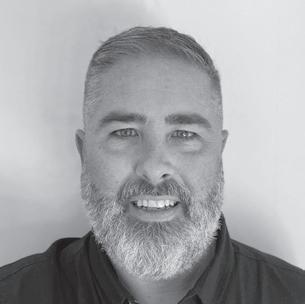

Stephen Fallon
Stephen Fallon is a teacher of History, English and Media in St Raphaela's Secondary School, Stillorgan, Dublin. He has been teaching for the past 20 years and is passionate about his subjects. His post of responsibility has been in running the school social media, communications and website. He currently holds a post as year head in his school. He has organised, co-ordinated and participated in several cultural and historical trips both in Ireland and abroad.
2
SAMPLE
LIFE IN AN ANCIENT CIVILISATION OUTSIDE IRELAND – ANCIENT ROME 17 4.1 The Spread of the Empire 4.2 Homes in Ancient Rome 4.3 Life in Ancient Rome 4.4 Roman Entertainment 4.5 The Roman Army 4.6 Sample Question A 4.7 The Contribution of Ancient Rome to Europe and the Wider World 4.8 Sample Question B 4.9 Sample Question C LIFE IN AN ANCIENT CIVILISATION OUTSIDE IRELAND –Topic 4 ANCIENT ROMESAMPLE
4.1 The Spread of the Empire
> The Roman Empire began to develop around 800 B.C.
> It became a very large empire ruled by famous emperors and dictators such as Julius Caesar.
> The Roman Empire lasted for over 1,000 years and stretched from Italy through most of Europe, North Africa, and parts of the Middle East.
> During this period, Rome was the largest and most important city in the world.
4.2 Homes in Ancient Rome
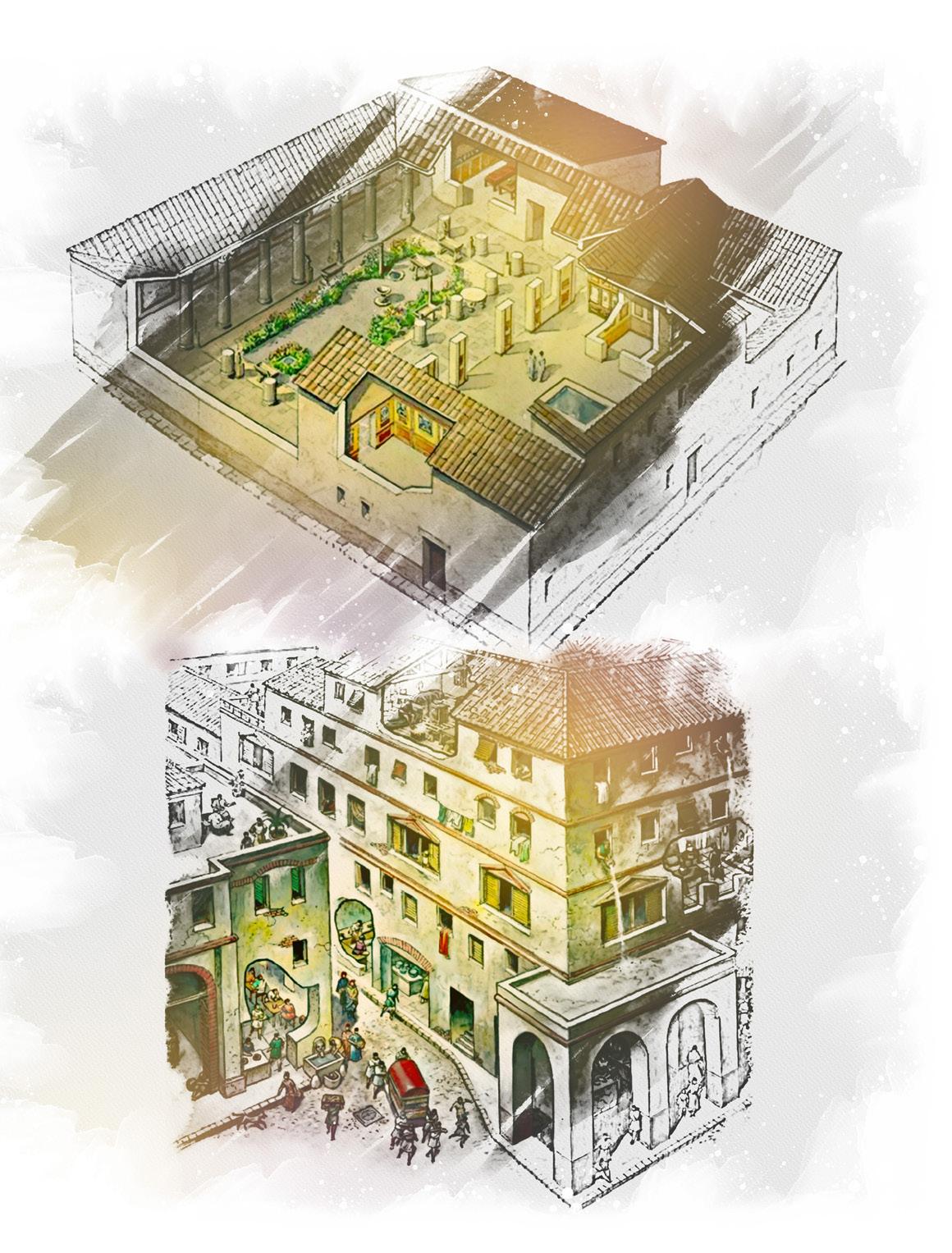
Roman society was divided into patricians (rich, upper classes) and plebeians (poorer, working classes).
> Patricians lived in a one-story house called a domus
> The domus had an entrance hall called an atrium (an open square), which had fountains and statues.
> There was a walled back garden called a peristyle, where plants, fruit trees and vegetables were grown.
> Some had an impluvium (small pool) around which the cubicula (bedrooms) and culina (kitchens) were built.
> They ate their meals in the triclinium (dining room). There was often a shrine to the gods, called a lararium
> The walls of their homes were decorated with murals and mosaics. The houses of rich Romans also had toilets. They often had a villa in the countryside as well.
> Plebeians lived in apartment blocks called insulae. These could be seven or more stories high.
> Lower-floor apartments could be large and comfortable, but most were in poor condition. Families lived in one room, which had no running water.
> The upper-floor apartments were cramped and uncomfortable. They were reached by a ladder rather than stairs.
> Rubbish and the toilet pot contents were thrown onto the street below. Plebeians would eat at a local popina, thermopolia, or taverna.
Topic 4 18
Roman Insulae
SAMPLE
Roman Domus
4.3
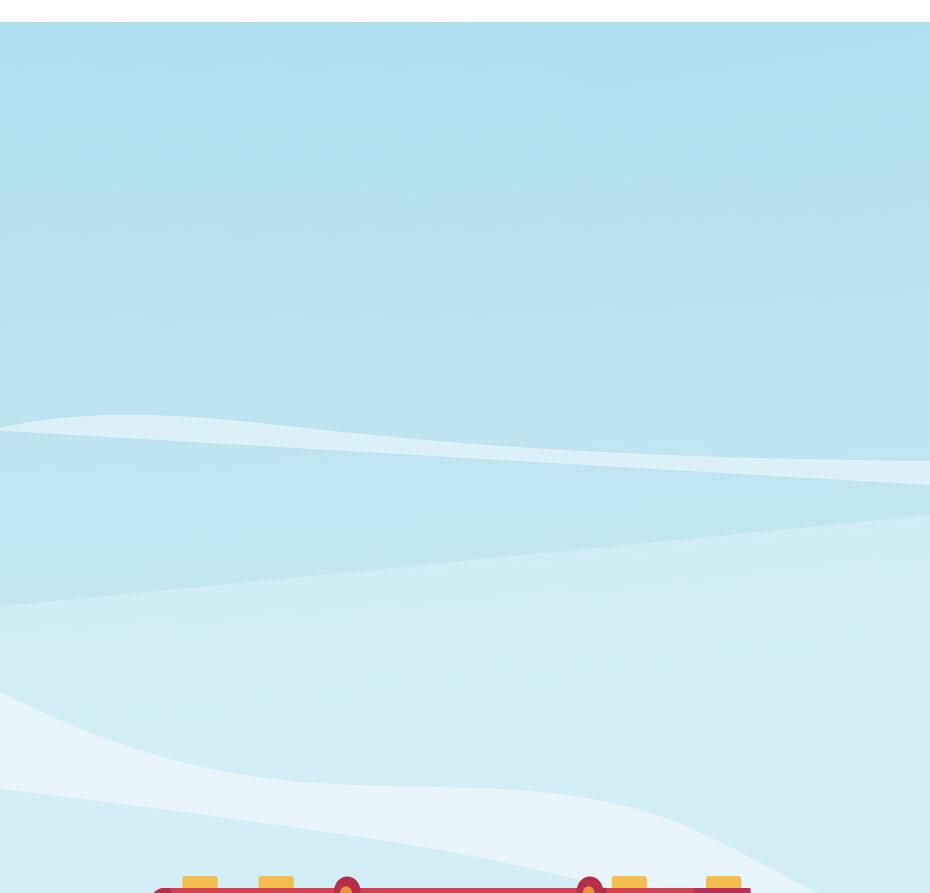


Life in Ancient Rome
Roman society was patriarchal; the father was the head of the family. Patrician men were magistrates or senators, while plebeian men were traders, craftsmen or shopkeepers.


A patrician woman supervised the slaves, who did the housework, while plebeian women might have worked in the family business. However, women had very little freedom and they did not have the same legal status as men. They were not allowed to vote or run for political positions.
At the age of 7, children were sent to a ludus for reading, writing, and arithmetic. At age 12, boys went to the grammaticus for subjects such as history, rhetoric, and oration. At age 12, girls stayed at home and learned how to run the home.
Men wore a shirt-like tunicand a toga over their tunic, while women wore a stola (dress) and a palla (shawl). Children wore a lucky bulla (a locket around their necks to protect them).

Slaves were usually captured during wars and then sold. Many were manual workers who worked in farms, mines, and shops, while educated slaves were doctors, teachers, or secretaries. They were owned by those who bought them and had to work without pay. Slaves were often treated badly, but could become freedmen by buying their freedom (manumission). Approximately 25% of all people in the Roman Empire were slaves.
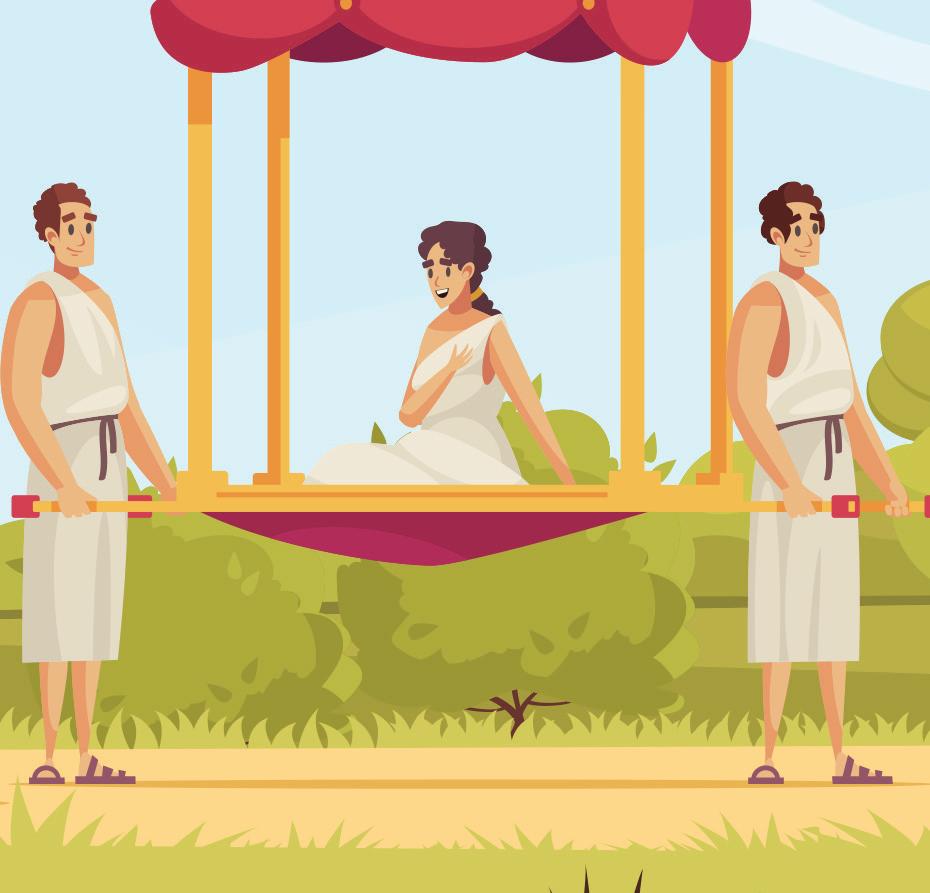
The Romans were the first civilisation to use music at large events and celebrations. It would be played at arenas, festivals, and religious events. Singing was accompanied by instruments such as aulos (pipes), lyres, and percussion
Romans worshipped at temples; for example, the Pantheon. They were polytheistic and believed in many gods; for example, a solider going to war might pray to Mars
Cena (main meal) consisted of fruit, meat and seafood. Rich Romans might eat crow, dormice, swan and peacock. Some Romans used garum (fermented fish sauce) to disguise the taste of rotten food. Poorer Romans were given a dole (free grain). They ate at thermopolia (takeaways).
LIFE IN AN ANCIENT CIVILISATION OUTSIDE IRELAND – ANCIENT ROME 19
Music Religion Food and eating SAMPLE
Men Women Education Clothing Slaves
4.4 Roman Entertainment
> Circus maximus/Hippodrome: Chariot races were held in a 250,000-capacity stadium.
> The Colosseum was a 50,000–70,000-seat amphitheatre in which gladiator contests were held. Many gladiators were slaves. They ate a carbohydrate-rich diet and trained in ludi. They wore armour, used weapons, and had to fight each other.
> Venatores gladiators were trained and had weapons; they engaged in staged hunts of wild animals such as lions and bears.
> Bestiarii gladiators were criminals or prisoners who were forced to fight wild animals without weapons.
> The Romans enjoyed going to the theatre to watch staged scenes and plays; for example, comedy plays by Plautus and tragedies by Seneca were very popular.
> Huge aqueducts moved water into cities to supply the Roman baths. Romans went to the baths every day to exercise, relax, do business, or socialise.
4.5
The Roman Army SAMPLE
> The army was divided into legions of about 4,000 soldiers. Each legion was then broken into smaller groups of 100 soldiers called centuries
> They were very disciplined; they had to live in a barracks and had to be able to complete 30-km marches several times a month.
> The baths consisted of a caldarium (hot room), tepidarium (warm room) and a frigidarium (cold room), with a palaestra (exercise court), libraries, and gardens.
> They carried all their equipment (40 kg) – for example, a shield (scutum), a dagger (pugio), a javelin (pilum), and a sword (gladius) –and they wore helmets. Soldiers served for 20–25 years. When they retired, they were each given a plot of land.
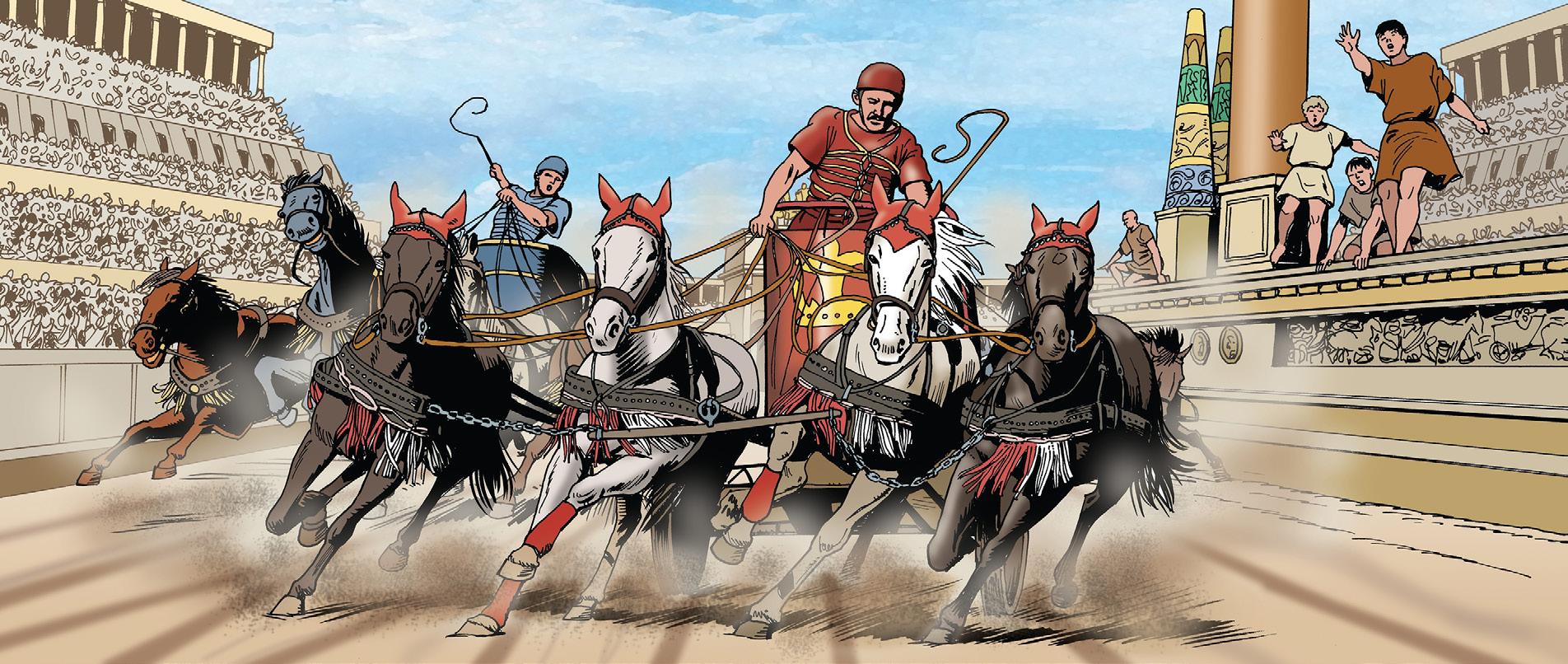
Topic 4 20
Chariot Racing at Circus Maximus
4.6
Sample Question A
(i) Identify a historical figure from an ancient civilisation who you believe is an important person in history.
(ii) Explain why you think this person is such an important person in history.
(i) Named historical figure: Julius Caesar
(ii) Explanation: Julius Caesar was born in July, 100 B.C in Rome into an aristocratic and influential family; his parents were well-off. At the age of 6, he began his education. He was educated by a tutor, and he learned how to read and write. He also learned about Roman law and how to speak in public. These were important skills he would need as leader of Rome. Caesar's father died when he was 16 years old, and he became head of the family. At the age of 17, he married the daughter of a powerful Roman politician. He joined the army and proved himself as a very able soldier and officer. On his return, he impressed people with his skill as an orator. He married twice more, each time into other influential Roman families, creating alliances with important figures.
Undoubtedly, his leadership and his military successes highlight how important he was. In Spain, he became a governor, bringing peace to an area troubled by warring tribes. When he returned to Rome, he jointly ruled with Pompey and Crassus, bringing in some popular reforms. He was governor of Gaul for 8 years, subduing tribes and conquering new lands in Belgium and Britain. This expansion of Rome’s territory increased the power and influence of the Roman empire and helped spread Rome's achievements and advances further.
When his opponents in Rome demanded his return, he used plundered riches from Gaul to support his army and marched them across the Rubicon, from Gaul into Italy. It sparked a civil war between Caesar’s forces and those of his main rival for power, Pompey, from which Caesar emerged victorious and became a dictator. He is important due to his influence when he was in power. He used his power to enlarge the senate and he decreased Rome's debt. He sponsored the building of the Forum Iulium and rebuilt two city-states, Carthage and Corinth. In addition, citizenship was granted to foreigners living within the Roman Republic.
Julius Caesar was important in the history of Ancient Rome because he was responsible for Rome changing from a republic to an empire.
He ruled without consulting the senate, which made other senators unhappy. Some senators plotted his death, and he was assassinated by stabbing on 15 March, 44 B.C.
LIFE IN AN ANCIENT CIVILISATION OUTSIDE IRELAND – ANCIENT ROME 21
SAMPLE
4.7
The Contribution of Ancient Rome to Europe and the Wider World
Aqueducts
Primary sources and artefacts
They created well-built aqueducts that carried water into the cities; for example, Nimes in France.
The Romans left behind an array of primary sources. Ancient ruins and artefacts (Herculaneum, Pompeii, the Colosseum) give historians a lot of information about life in Ancient Rome.
Engineering and architecture
The Romans were great engineers and builders. They were the first in Europe to discover concrete, which helped make their buildings more durable. They learned how to build rounded arches, columns, and domes. Many Roman buildings are still standing today; for example, the Pantheon, which shows how well-built they were. Many techniques developed by the Romans were used in the Renaissance and influence modern architecture today.
Roads
Latin language
The Romans were impressive road builders. They built 84,800 km of roads using large stones on sand or gravel.
As the empire spread across Europe, Southwest Asia and North Africa, they brought their traditions and the Latin language with them. Although not spoken today, Latin was the basis of languages like Portuguese, Spanish, Italian, French, and Romanian. Around a quarter of English words today are directly influenced by the Latin language.
Calendar
The Roman Julian calendar was used until the 16th century. It had 365 days and was divided into 12 months. Despite changes in 1562, it remains the basis for the calendar we use today. Many of the months are named after Roman emperors and gods.
Roman numerals
Christianity Sewage systems
Central heating
Shopping centres
Law and order Mosaics
I = 1, V = 5, X = 10, L = 50, C = 100, D = 500, M = 1,000.
Constantine converted Rome to Christianity in 312 A.D, and the Catholic faith spread with the Roman Empire. The Vatican in Rome is still the centre of the Catholic Church.
They created sewage systems in their towns.
The Romans designed the first systems of underfloor heating.
Trajan’s Forum is considered to be the first shopping centre in the world.
They established a system of state and civil law.
The Romans created beautiful mosaics on floors and walls.
Topic 4 22
SAMPLE
Sample Question B
From your knowledge of an ancient or medieval civilisation of your choice, write an account of the lives of people who were part of that civilisation.
In your account, examine at least two of the following: housing, religious beliefs, food and drink, working life, leisure, war and defence.
(i) The civilisation I have studied is Ancient Rome. I will describe housing and leisure in my account.
(ii) Housing: Rich Romans lived in a house called a domus. It had an entrance hall called an atrium (an open square) and a walled back garden called a peristyle. Some had an impluvium (small pool) around which the cubicula (bedrooms) and culina (kitchens) were built. They ate their meals in the triclinium (dining room). There was often a shrine to the gods, called a lararium. The walls of their homes were decorated with murals and mosaics. The houses of rich Romans had toilets. Poor Romans lived in apartment blocks called insulae. Some apartments were large and luxurious, but most were in poor condition. Families lived in one room with no running water. The upper floors were reached by a ladder rather than stairs. Rubbish and the toilet pot contents were thrown onto the street below.
Leisure: Romans enjoyed many leisure pursuits and various forms of entertainment. In the Circus Maximus, they watched chariot races held in a 250,000-capacity stadium. They visited the Colosseum, where gladiator contests were held. They enjoyed visiting the theatre to watch performances and plays; for example, comedy plays by Plautus were very popular. They also visited the Roman baths to relax, to exercise, and to meet friends. The baths consisted of a caldarium (hot room), a tepidarium (warm room), and a frigidarium (cold room) as well as a palaestra (exercise court), libraries, and gardens.
LIFE IN AN ANCIENT CIVILISATION OUTSIDE IRELAND – ANCIENT ROME 23
4.8
SAMPLE
4.9 Sample Question C
Name an ancient or medieval civilisation you have studied – for example, Romans, Egyptians, Vikings – and explain two ways in which the actions and/or achievements of that civilisation were important to history.
I studied Ancient Rome. Ancient Roman achievements were very important in history and have left a significant legacy.

Firstly, the modern calendar is based on the calendar introduced by Julius Caesar in 46 B.C. This divided the year into 365 days over 12 months. The Julian calendar was replaced by the Gregorian calendar in the 16th century when the Julian calendar became too out of line with the movements of the Sun.
Secondly, the Latin language has left an important legacy. As the empire spread across Europe, Southwest Asia and North Africa, the Ancient Romans brought their traditions and the Latin language with them. Although not spoken today, Latin was the basis of languages such as Portuguese, Spanish, Italian, French and Romanian. Around a quarter of English words today are directly influenced by the Latin language.
Having studied this topic, you should now have a better understanding of the following learning outcomes: 1.1, 3.1.
Topic 4 24
SAMPLE
57
CONSEQUENCES
REVOLUTION
10
10.1 Background 10.2 Sample
A 10.3 The Build-Up
Revolution 10.4 The
Revolution 10.5
10.6
Questions B
C 10.7 The
CONSEQUENCES
THESAMPLE
CAUSES AND
OF THE AMERICAN
Topic
AMERICAN REVOLUTION
Question
to the American
American
An American Revolutionary Leader: George Washington
Sample
and
Consequences of the American Revolution CAUSES AND
OF
10.1 Background
> In the early 1600s, the first Europeans (other than the Spanish) arrived in North America and began colonising it.
> By 1750, the British had control of 13 colonies in America on the eastern side, while the French controlled others, and Spain controlled Central and South America.
10.2 Sample Question A
> The British had a governor in each of the colonies.
> Most of the colonists considered themselves to be American rather than British, and wanted change for several reasons.
Write an account of the causes of a pre-20th century revolution in Europe or the wider world that you have studied.
Revolution: The American Revolution
Causes: The American Revolution had several causes, many of them going back years before the revolution began.
The British army in America were known as the Redcoats, and they were there to protect the colonists from attack by the French and the Indians, but also to protect British interests, which further angered the colonists.
The British decided to increase taxes on the colonists to pay for the Redcoats, and introduced the Quartering Act in 1765.
They introduced the Stamp Act, which was a tax on newspapers; the Townshend Act, which was a tax on tea, and the Navigation act, which forced the colonists to sell goods such as cotton and tobacco only to Britain at prices decided by the British. These taxes would lead to increased hostility among the colonists, which would eventually result in revolution. Many colonists refused to pay the taxes, their slogan being ‘No taxation without representation’.
58 Topic 10
SAMPLE
CAUSES AND CONSEQUENCES OF THE AMERICAN REVOLUTION
10.3
The Build-Up to the American Revolution
> In 1770, colonists marched in protest against taxes. Five of them were killed by the British. This was called the Boston Massacre.
> In 1773, the British tried to bring their own tea onto the American market without paying the tax due from the Tea Act. The colonists, dressed as native Indians, dumped the tea into Boston Harbor in what became known as the Boston Tea Party.

> In 1774, a meeting of leaders from all of the colonies was held, called the First Continental Congress. At the Congress, it was demanded that British soldiers leave, and the delegates declared that they wanted
to boycott all British goods. The slogan of the colonists was 'no taxation without representation'.
> After this meeting, certain groups in America began stockpiling weapons in preparation for war.
10.4 The American Revolution
> In 1775, the first shots of the rebellion were fired at Lexington and Concord.
> The British sent troops to seize weapons in Concord, but were attacked by colonists led by Paul Revere at Lexington.
> The weapons were gone by the time the British got to Concord, and over 200 British were killed when they were attacked again on their way back.
> In 1776, a second Continental Congress was held, and it was decided here that Washington should be commander-in-chief of the American troops.
> On 4th July 1776, the Declaration of Independence was issued.
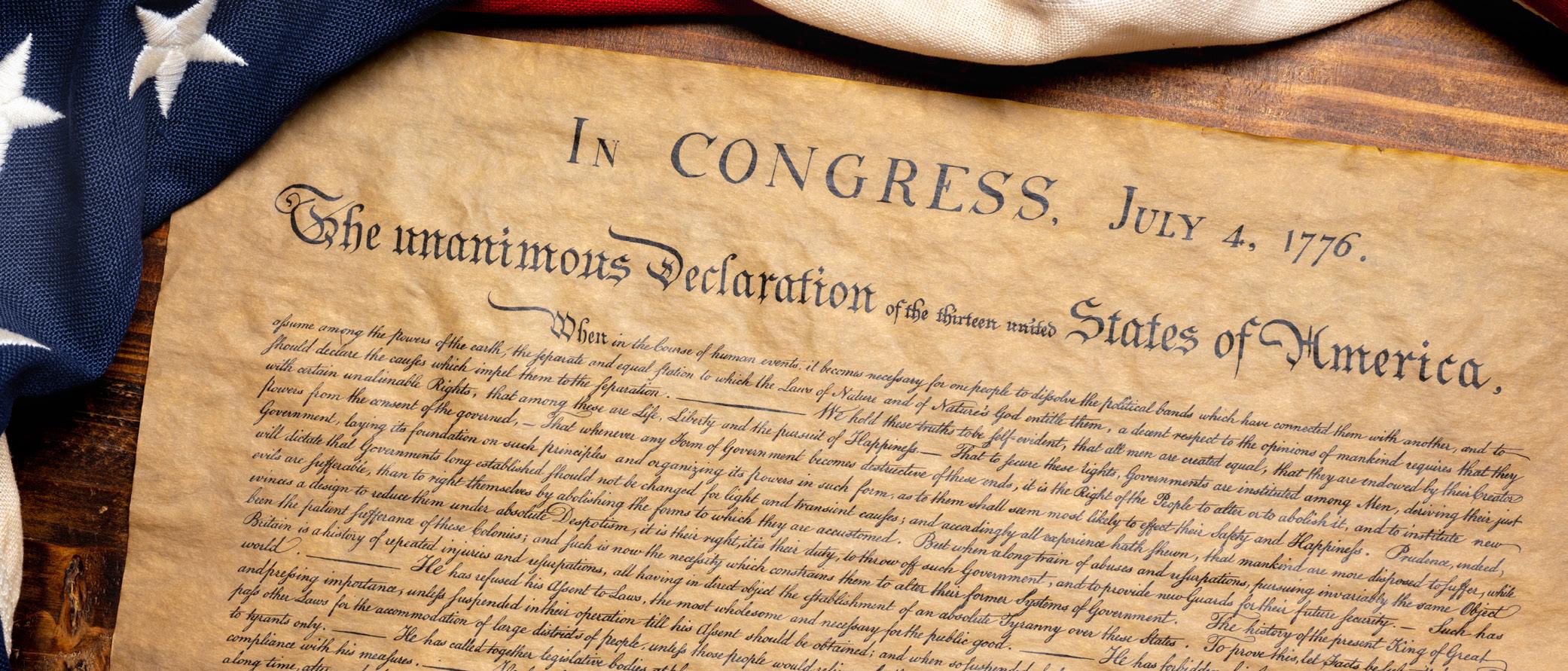
SAMPLE
The American Declaration of Independence
10.5
An American Revolutionary Leader: George Washington
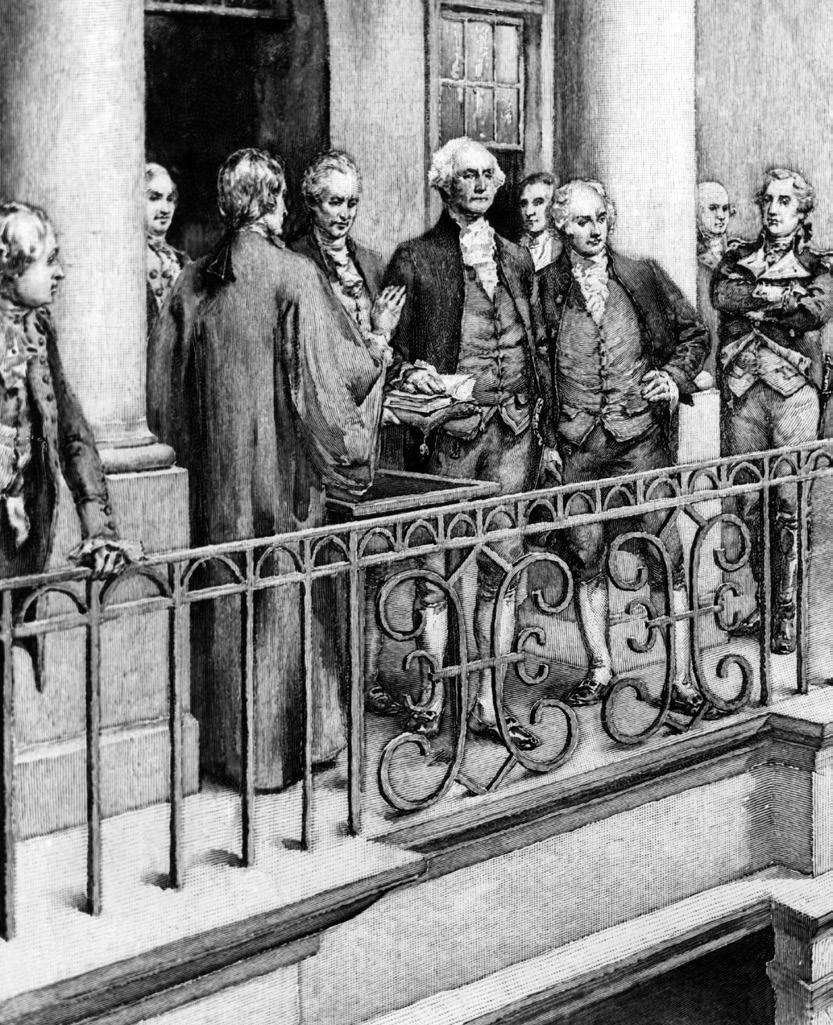

> He was born in 1732 in Virginia.
> He came from a wealthy plantation owner background, and his marriage to Martha Dandridge (a very wealthy widow) only served to increase this wealth.
> He became a soldier and fought against the French during the Seven-Year War.
> He was sent to the First and Second Continental Congresses as the delegate for Virginia.
> At the Second Congress, he was made leader of the army because of his experience in the Seven-Year War.
> After initial victories in Boston, he lost the battles of Bunker Hill in 1775 and New York in 1776, and the largest city of Philadelphia in 1777.
> The Americans won the next battle at Saratoga, which gave them renewed hope.
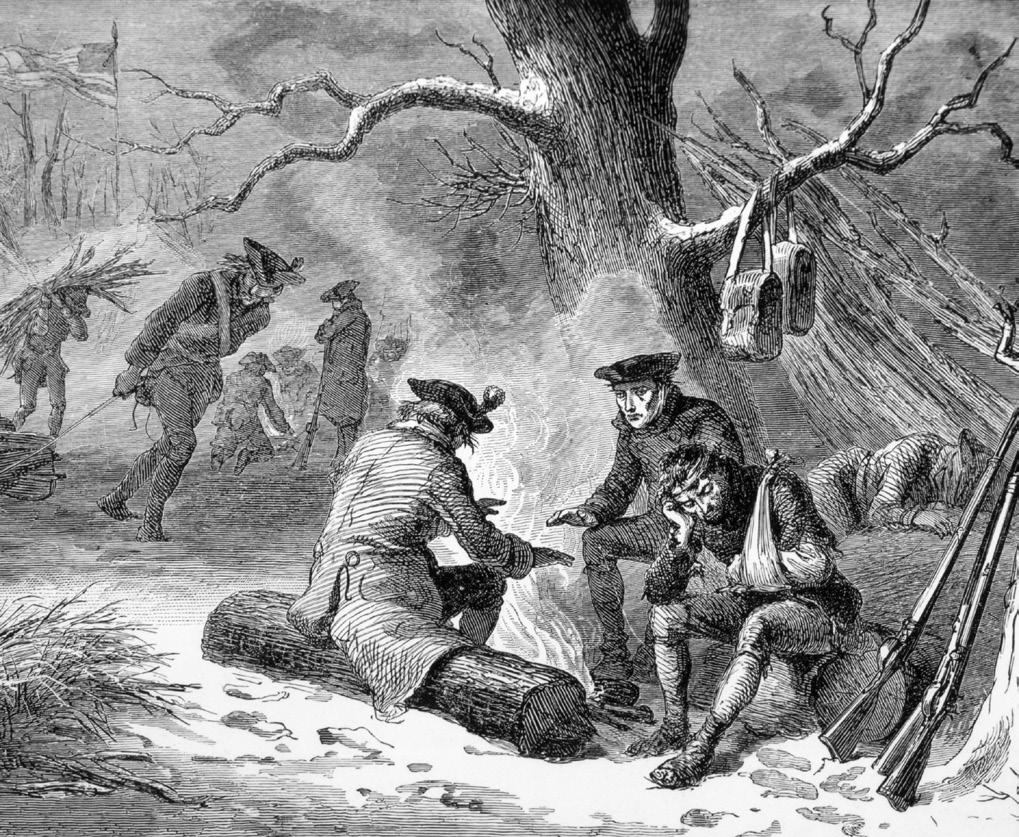
> He won the loyalty of his men after sharing their hardship and lack of food when they had to spend the winter of 1777–1778 in freezing conditions in Valley Forge.
> It was at this point that the French sent help (troops and weapons), which helped swing the war for Washington and America.
> In 1781, he won at Yorktown (the decisive battle), as the British General Cornwallis, who was surrounded, surrendered.
> In 1783 in France, the British were forced to accept American independence at the Treaty of Paris, which stated that America was completely independent of Britain.
> He went back to Mount Vernon, but returned and helped in the drafting of the American Constitution in 1787.
> It was decided that America should be a republic.
> This meant that power would be separated between a supreme court, a president, Congress, and the individual states.
> He became the first president in 1789 and would remain as president for eight years.
> He died in 1799.
> The capital of America was named Washington after the death of George Washington, in his honour.
60 Topic 10
George Washington's inauguration as President
SAMPLE
American soldiers at Valley Forge 1777
10.6 Sample Questions B and C
This is an engraving by Paul Revere, who fought against the British in the American Revolution. It shows his version of the Boston Massacre of 1770. Examine it and answer the questions that follow.
B. Why is it important to know that Revere was a supporter of the Revolution when assessing the reliability of this source ?
C. This picture was published all over America and led to a lot of anger towards the British. Is it an example of propaganda ? Explain your answer.
B. It is crucially important to know the background of the individual giving the information when judging the reliability of any source.
In this case, Paul Revere was directly involved in the events of the revolution, which might have added to his reliability; however, he fought on the American side, so the possibility of evidence given by him being biased is very strong.
This is obviously the case in this picture, as it portrays the British Redcoats badly: well armed and shooting at an unarmed, defenceless American crowd.
C. Yes, I do believe that this picture is an example of propaganda.
Propaganda is designed to influence how people think, and in this case, Revere portrays a very one-sided version of the Boston massacre, showing the British Redcoat army shooting and killing the unarmed defenceless American people.
Pictures like this are designed to get a reaction and to influence how people think, and the American people were bound to be angry after seeing the events portrayed like this.
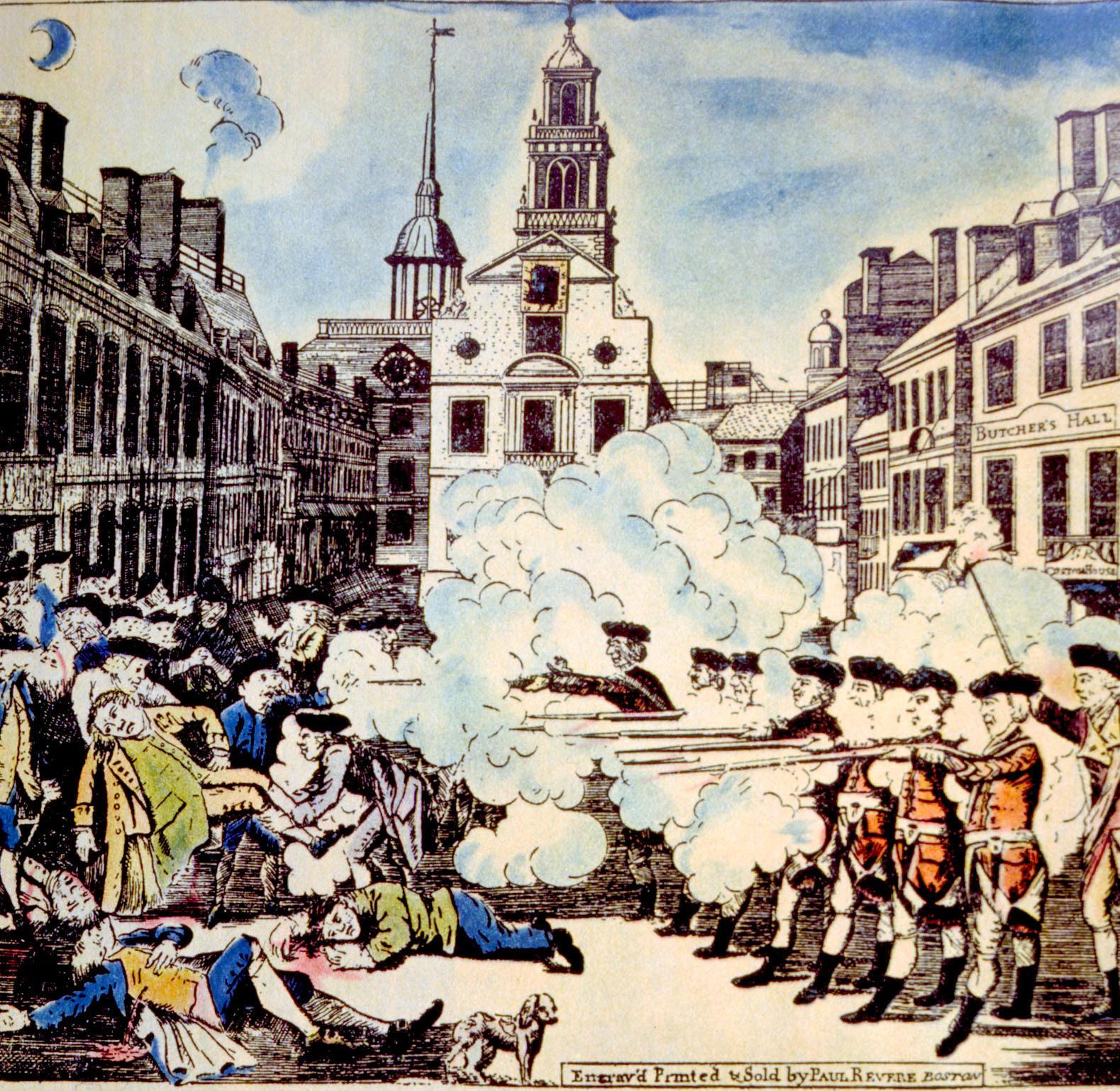
61
CAUSES AND CONSEQUENCES OF THE AMERICAN REVOLUTION
SAMPLE
Britain had control of 13 colonies

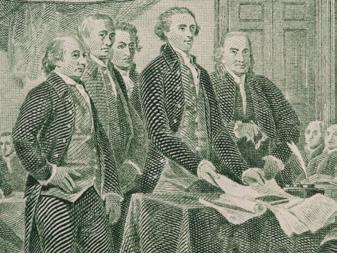
> The second Continental Congress –Washington becomes head of American armed forces > 4th July 1776 –The Declaration of independence 1774 SAMPLE
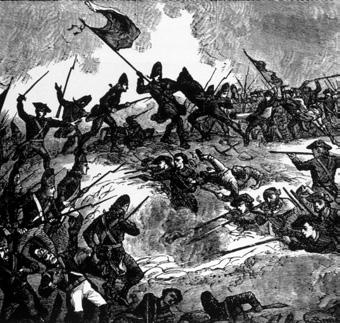
The Quartering act introduced > The first shots are fired at Lexington and Concord > The Americans defeated at Bunker Hill
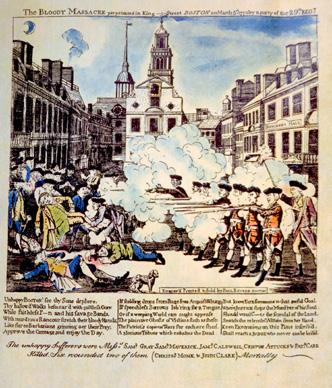
62 Topic 10
> The 7-year war between Britain and France
>
>
1756-1763 1770 1776 1750 1765 1775 > The
Tea
> The First Continental congress – a meeting of representatives from all the states > The Boston Massacre – the redcoats open fire, killing 5 1773
Boston
Party
1777
> Washington spends the harsh winter alongside his troops at Valley Forge
1781 1787
> The Americans win the decisive battle at Yorktown and General Cornwallis surrenders
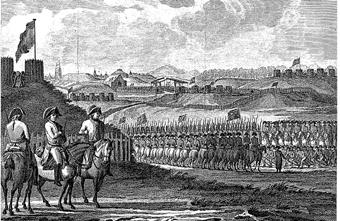
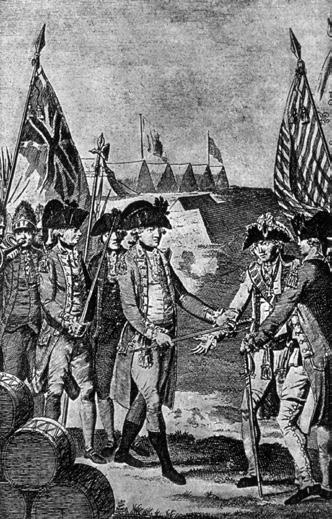
1777-1778 SAMPLE
> The French send troops and weapons to help the Americans

> The Americans defeated in Philadelphia 1778
> The Treaty of Paris is signed recognising American independence
1783 1789
> Washington becomes the first President of America
63
CAUSES AND CONSEQUENCES OF THE AMERICAN REVOLUTION
> The American Constitution is drafted
10.7 The Consequences of the American Revolution

> The success of the American revolution had an impact all around the world.
> Other countries, France and Ireland, for example, experienced rebellions of their own in 1789 and 1798 respectively, having been directly influenced by events in America.
> People in other countries wanted the same rights that the Americans had earned for themselves.
> America would continue to grow from this point, eventually comprising 50 states.
> The Native American population were, however, almost completely wiped out.
> Slavery was in place at this time and would continue to exist in America for the next 200 years.
> As America grew, it became known as ‘the Land of Opportunity’, with the upshot that millions left their own countries and moved to America.
> Ireland is a prime example of the flow of people to America. During the Famine, between 1 and 5 million people left Ireland, many destined for America. Today, over 31.5 million people in America claim to have Irish ancestry.
Having studied this topic, you should now have a better understanding of the following learning outcomes: 1.1, 1.9, 1.10, 3.3.
64 Topic 10
SAMPLE
THE COLD WARSAMPLE
181 THE COLD WAR Topic 26
26.1 Background 26.2 Reasons for the Cold War 26.3 America's Policies for Dealing with Communism 26.4 Sample Question A 26.5 The Berlin Blockade, 1948–1949 26.6 The Korean War, 1950–1953 26.7 Sample Question B: Cuba 26.8 The Vietnam War 26.9 Russia and the Eastern Bloc Countries 26.10 Mikhail Gorbachev and the End of Communism
26.1 Background
> Despite the fact that Russia and America were allies during World War 2, there was still a mistrust between both countries.
> An example of this was Stalin’s anger at America’s refusal to share their atomic secrets.
> After World War 2, America and Russia were the only two superpowers left. Both sides despised each other because of their different ideologies.
> Over the next 45 years, there would be dislike and distrust between the two and competition in all areas; for example, land, space, weapons, and control.
> They came close to war on a couple of occasions, the closest being the Cuban missile crisis of 1962.
26.2
Reasons for the Cold War
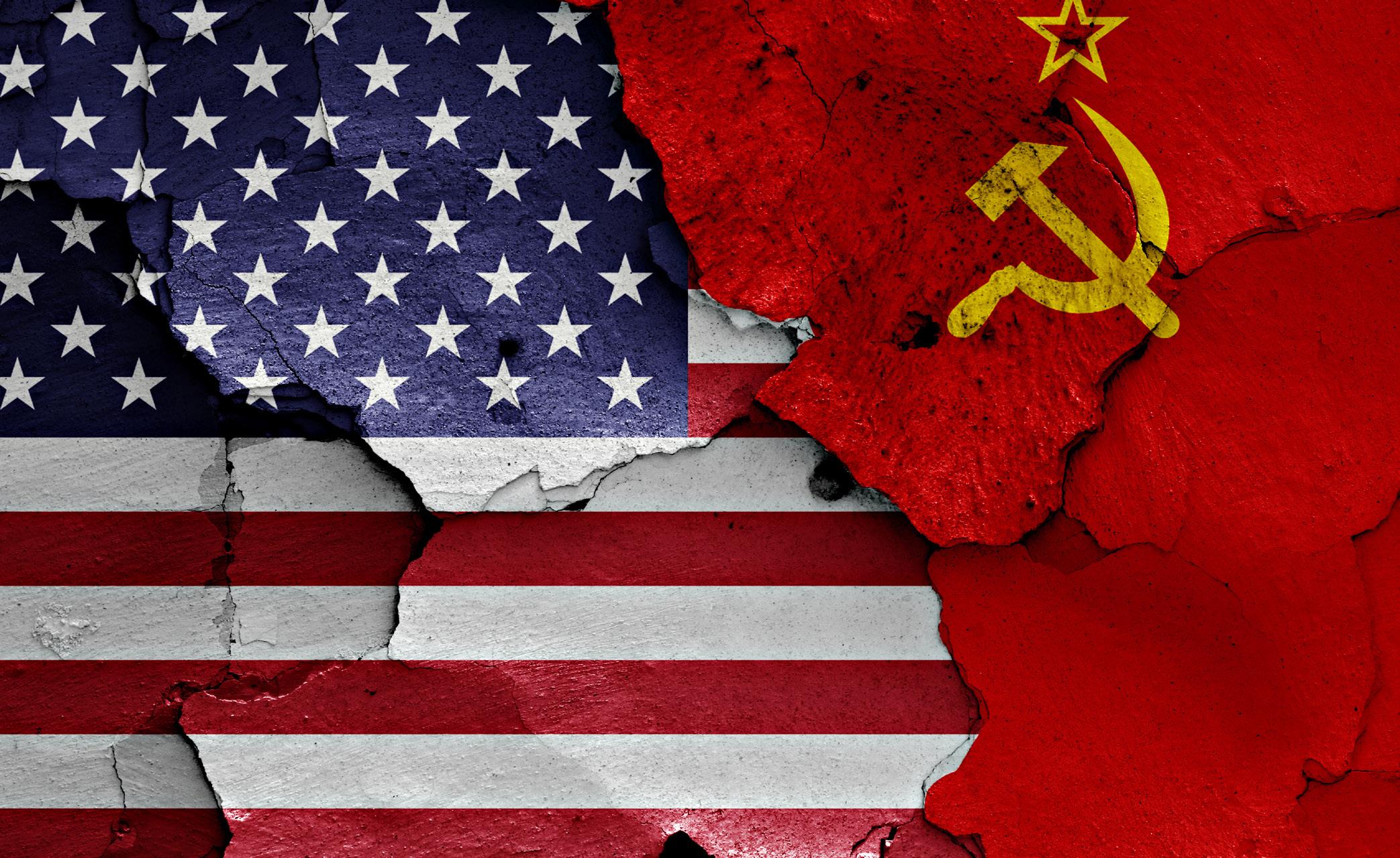
> Russia was a communist country, which meant that the state had full control over factories, businesses, property, land, and the lives of its people. Democracy was not allowed.
> America, on the other hand, was a capitalist country, which meant people were free to own their own businesses and their own property and, if they worked hard, to become wealthy. Democracy was in place here.
> Both sides despised each other.
> After World War 2, Russia began increasing their ‘sphere of influence’. They did this by putting communist governments in control of a buffer zone of countries such as Poland, Bulgaria, Romania, and Yugoslavia.
> These countries were known as satellite states of Russia.
> America was afraid of the spread of communism.
> Winston Churchill said in 1946 that ‘an iron curtain’ had descended over Europe, meaning that communism was forcing its people to stay inside this curtain.
182
SAMPLE
26.3 America's Policies for Dealing with Communism
> President Truman introduced the Truman Doctrine, which involved giving military aid to countries like Greece and Turkey to stop them from becoming communist.
> America introduced the Marshall Plan, which involved giving large amounts of money to countries in Western Europe to allow them to develop, and thus to avoid becoming communist.
> Truman had a policy of containment
26.4 Sample Question A
This meant that America would not allow communism to spread to places beyond where it already was.
> The Domino Theory meant that Americans thought that if one country in a region became communist, all the other countries around it would follow.
> Deterrence meant building up enough nuclear weapons to frighten the Russians off from ever starting a nuclear war.
Do you think that this cartoon is biased or neutral in its portrayal of America’s role in the Cold War? Explain your choice with reference to the cartoon.
I believe that the cartoon is biased in favour of America’s role in the Cold War and is very pro-American based on that cartoon. The Russians are symbolised by the bear, who in this cartoon is standing above the Eagle, which represents America, in a very threatening manner, giving the impression that the aggression is coming from the Russians. There are two phrases in this cartoon: ‘irresponsible statements‘ and ‘deepening suspicions’, both of which are placed on the Russian side of the gulch or gap, yet again giving the impression that these comments are in reference to their behaviour. As a result, I do believe that this cartoon is biased in favour of America.
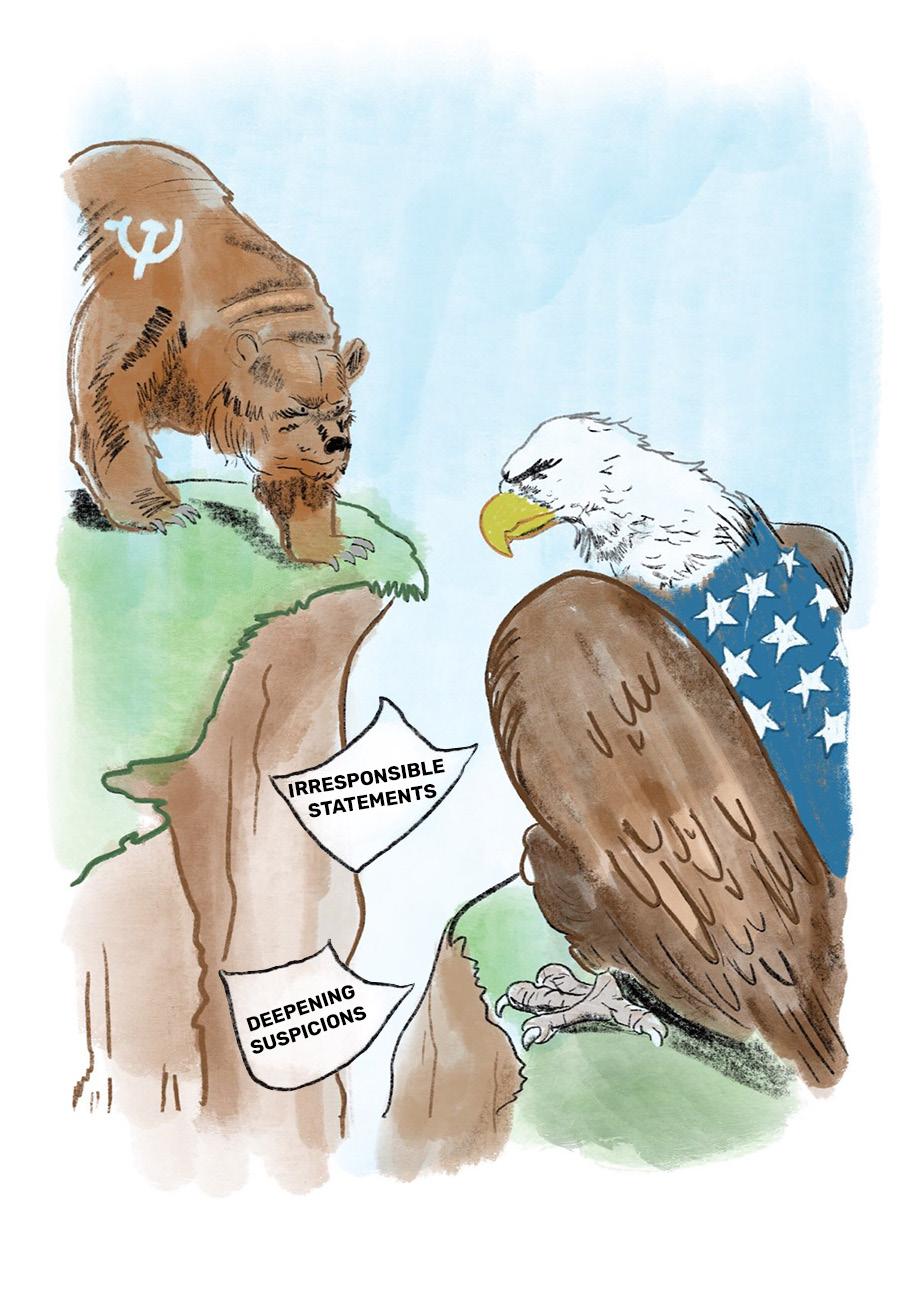
183 THE COLD WAR
SAMPLE
The Berlin Blockade, 1948–1949
> After World War 2, Germany and Berlin were divided into four zones.
> France and Britain controlled two of them, but the two most important were controlled by Russia and America.
> Both sides realised the importance of Germany, and of Berlin in particular.
> Stalin saw Berlin as his opportunity to spread communism further, while Truman saw Berlin and Germany as the barrier to communism.
> The allied countries of America, England, and France wanted a financially strong Germany so that it would not become Communist.
> In 1948, they introduced a new currency called the Deutsch Mark to ensure this.
> Stalin was furious at this, so in August 1948, he sent Russian troops to blockade any
entrance to West Berlin (the American part of Berlin).
> America responded by airlifting and dropping food and supplies into West Berlin.
> This became known as Operation Vittles.
> Stalin did not believe that America would continue doing this all winter long.
> America, on the other hand, carried on dropping supplies for the next 10 months until May 1949.
> Stalin at this point withdrew his troops, which was seen as a victory for containment.
> Berlin was now split in two for good, with Russia controlling the east and America controlling the west.
> In 1961, the Russians built the Berlin Wall to separate both parts of Germany.

> In 1949, America, Canada, and 10 other countries set up NATO (the North Atlantic Treaty Organisation).
> This was a military alliance with huge nuclear capability.
> In the 1950s, the arms race grew, with billions being spent on nuclear weapons.
> In 1955, Russia created their own communist military alliance called the Warsaw Pact.
> To encourage other countries to join the Warsaw Pact, Russia gave both financial
and technological help to these countries to convince them that communism was better than capitalism.
> There were several attempts by America and Russia to improve relations in the 1960s and 1970s; for example, when JFK met Khrushchev (the Russian Leader) in Vienna in 1961, and the setting up of a hotline between the White House and the Kremlin (Russian headquarters) after the Cuban Missile Crisis of 1962.
Topic 26
26.5
Results of the Berlin Blockade
SAMPLE
Berlin Wall
The Korean War, 1950–1953
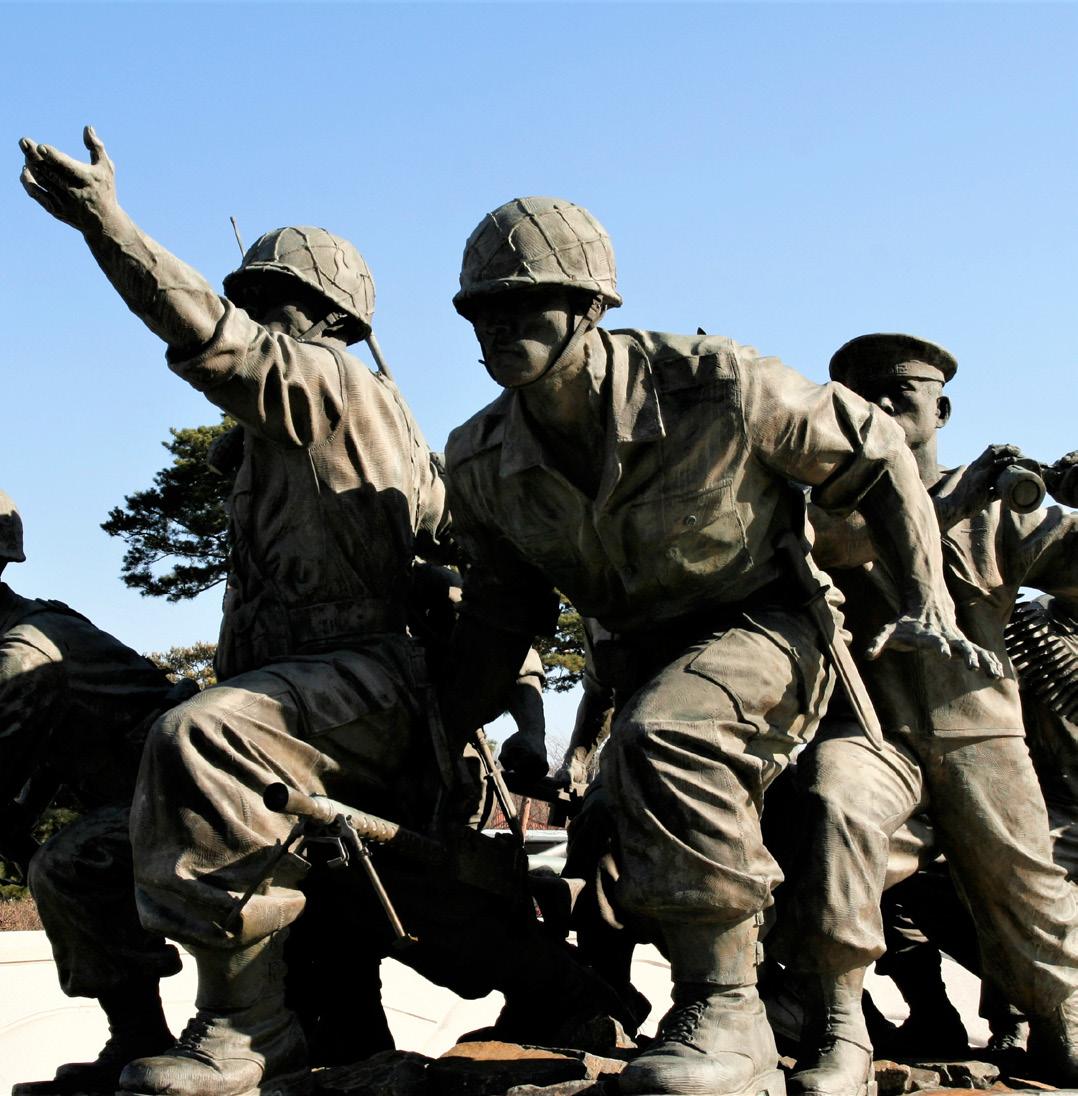
> Japan controlled Korea up until the end of World War 2.
> After World War 2, Korea was taken from Japan, and North Korea became communist, while the south was backed by America.
> In 1949, China became communist, which worried America.
> In June 1950, North Korea invaded South Korea.
> Truman, as part of his containment policy, did not want to let the North take over the South.
> Truman got support from the United Nations, which sent troops over to push the North Koreans back.
> The leader of the UN troops was a man named General Douglas McArthur, who had been a hero in World War 2.
> The border between north and south was at a line called the 38th parallel.
Outcomes of the Korean War
> It was called the forgotten war, but 2.5 million people died, including 33,000 Americans, and it cost $20 billion.
> North and South Korea were now split forever.
> America felt like this was a victory for their policy of containment. However, the Cold War had now moved to Asia.
> America signed treaties with Japan and the Philippines and in 1954 would begin their involvement in Vietnam.
> McArthur and his troops drove the North Koreans back over the border and started to head towards the Chinese border.
> The Chinese felt threatened by this move towards their border and moved 500,000 troops as a warning to McArthur not to cross their border.
> At this point, McArthur went public, saying China should be invaded, with atomic weapons used if necessary.
> Truman was left with no option but to sack McArthur, which would cost Truman in terms of popularity.
> In 1951, the North Koreans, backed by the Chinese, pushed the UN troops back over the border between North and South Korea.
> The fighting would continue for two more years, after which it was agreed that the border would remain at the 38th parallel, just where it had been when the war started.
185 THE COLD WAR
26.6
SAMPLE
Korean War Memorial
26.7 Sample Question B: Cuba
Between 1945 and 1989, many important events took place in the Cold War. Choose one of these events and write an account of it.
Event: The Cuban missile crisis, 1962
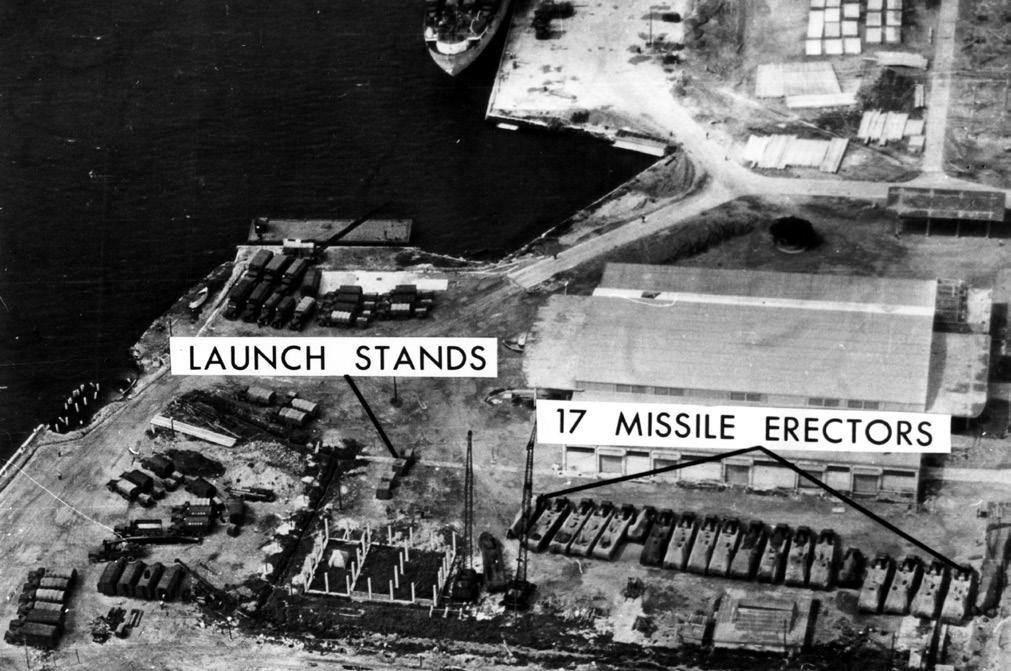
Up until 1959, Cuba was controlled by an American-backed government, called the Batista government.
However, in 1959, Fidel Castro led a communist revolution in Cuba. America was not happy about this as they felt it was bringing communism too close to their borders.
In 1961, the CIA were involved in a plot to overthrow Castro. It became known as the Bay of Pigs Invasion and was a disaster for America and for President John F. Kennedy.
The plan had been to send 1,500 Cuban exiles to start a revolution to overthrow Castro. Kennedy, however, refused to send planes or troops to back them, and they were easily defeated. Kennedy then looked weak and inexperienced in the eyes of the world.
In October 1962, an American U2 spy plane flying over Cuba took pictures of Russian nuclear missile sites on Cuba. Khrushchev (the Russian leader) had wanted weapons closer to America because America had nuclear weapons in Turkey. When the Americans saw the weapons sites, it was a massive problem, as from Cuba the Russians could pick off any city in America.
President Kennedy was left with three options: to invade Cuba (which could lead to war); to blow up the missile sites, which many army leaders wanted (but would also lead to war); or to create a blockade with American ships along the coast of Cuba as Russian ships with nuclear missile parts approached Cuba. Kennedy went with the blockade option. The Russians said openly that the ships would not stop or turn back for the Americans.
Kennedy set up a special group called Excomm to try and deal with the crisis. For 13 days in October 1962, the world came as close as it ever would to nuclear war. As the whole world watched, eventually the Russian ships stopped and allowed the Americans to check them or turned back. This was seen as a massive victory for President Kennedy and America. An agreement was reached between the two countries:
1. Russia would remove the sites from Cuba, and in return, America would privately remove their sites from Turkey.
2. A nuclear test ban was signed between the two countries to limit nuclear testing.
3. A hotline (a direct phone line between the White House and Kremlin) was set up.
The Cuban Missile Crisis during the Cold War was the closest the world would come to nuclear war.
Topic 26 186
SAMPLE
The Vietnam War26.8
> Vietnam had been part of Indochina (which was under French control up until 1954).
> France was driven out, and the communists called the Viet Minh, led by Ho Chi Minh, took control of the North.
> Because of their policy of containment, America got involved and backed the government of the South.
> They put a leader named Diem in charge of south Vietnam against the people’s wishes.
> Under Eisenhower, America began to send military aid and advisors to Vietnam.
> When President Kennedy took power in 1961, there were 1,500 US advisors in Vietnam. When he died in 1963, there were 23,000 US advisers in Vietnam.
> When Lyndon Johnson replaced him, he had two options: to pull out or to send in the troops.
> In 1965, the first American soldiers arrived in Vietnam.
> By 1968, America had 550,000 soldiers in Vietnam.
> America found it impossible to defeat the North Vietnamese, who used the countryside to their advantage and carried out guerrilla warfare against the Americans.
> The countryside suited this, and they had the support of the people living in the country in Vietnam.
> The Americans began using tactics such as fire-free zones; they used chemical weapons, and success was based on the body count.
> In the eyes of the world, America looked terrible.
> At home in America, a group called the anti-war movement was protesting all over America against the war.
> Up until 1968, Americans believed they were winning the war because their government told them so; however, this changed after the Tet offensive of 1968.
> The American people no longer believed their own government, and a credibility gap was created.
> When Nixon came to power, he realised America had to get out of the war.
Outcomes of the Vietnam War
> 58,000 Americans died, and the war cost $30 billion a year from 1968 onward.
> In 1973, the Paris Peace Agreement ended the war.
> In 1975, North Vietnam invaded the South, and the South became communist.
> Containment had failed in Vietnam due to America getting involved where it should not have.
> Divisions were caused in America that would last for years.
> This was the first war America had not won.
187 THE COLD WAR
SAMPLE
President Lyndon Johnson
Russia and the Eastern Bloc Countries
> The group of countries under Russian control during the Cold War was known as the Eastern Bloc
> Russia set up various different groups, but the aim was always the same: to keep total control of these countries.
> In 1949, they set up Comecon, which meant to give economic help, but in reality it was just to maintain control of these countries.
> In 1955, they set up the Warsaw Pact, which was a military alliance of all the Eastern Bloc countries to oppose NATO.
> They also set up Cominform, to ensure that all the communist parties in different countries were following Moscow’s lead.
> In general, Russia did not get involved too much with these countries unless they tried to break free from communism; they would then send the army to deal ruthlessly with it.
> For example, in 1956, the Hungarian uprising took place. There were huge protests against Russia and communism, but Russian troops crushed them within 13 days.
> In 1961, the Russians built the Berlin Wall to prevent people leaving East Berlin. For the next 28 years, they would have Russian soldiers on the wall.
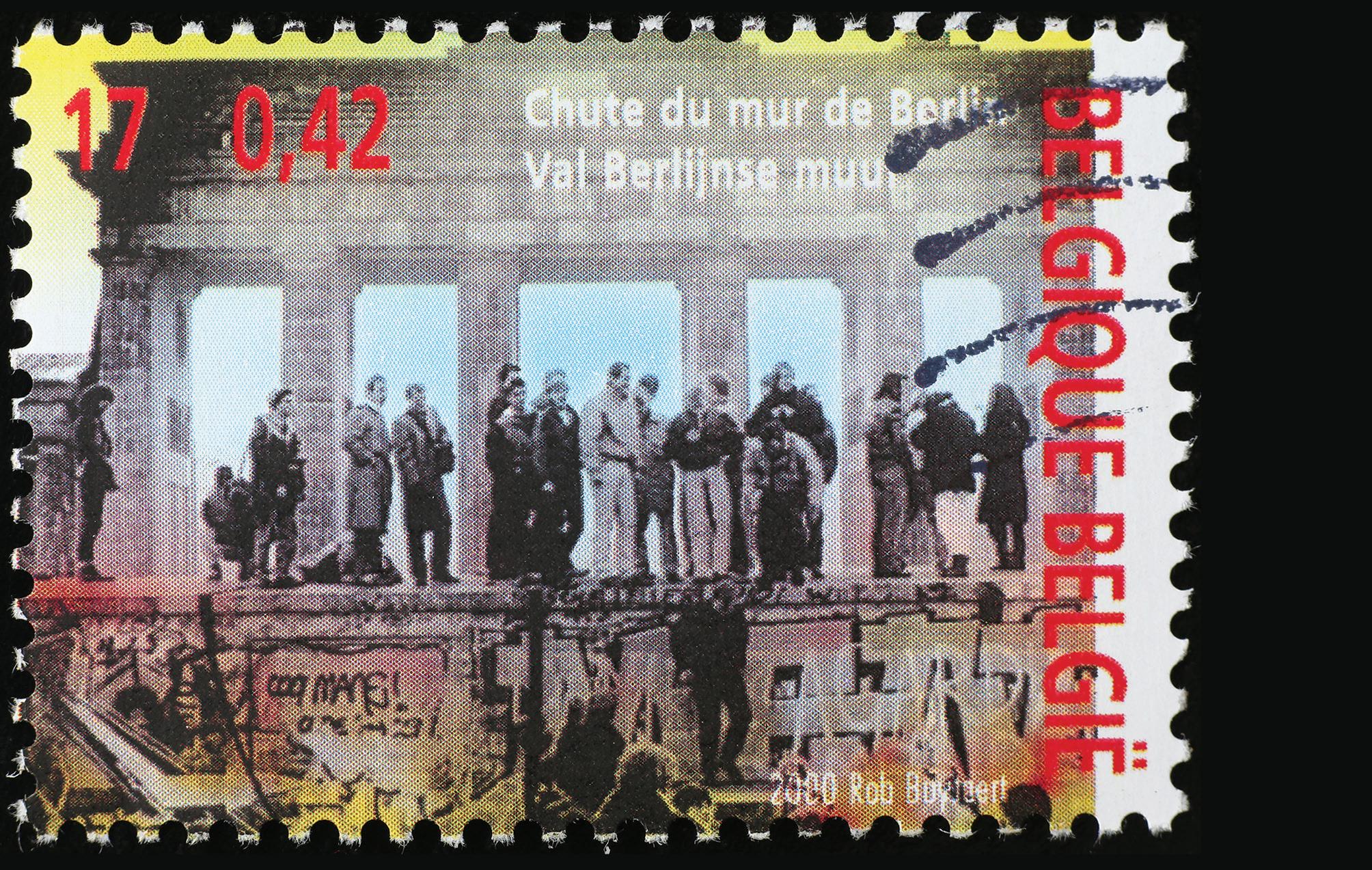
> In 1968 in Czechoslovakia, the Prague Spring took place; when the government tried to give more freedom to the people, the Russians sent in the tanks and crushed it. The same would happen in Poland in 1981.
> Russia created the USSR and kept it in place for over 40 years through the use of terror, but once it started to collapse, it collapsed very quickly.
Topic 26 188
26.9
SAMPLE
Stamp commemorating the Fall of the Berlin Wall
26.10 Mikhail Gorbachev and the End of Communism

> Gorbachev was born in 1931.
> He was a member of the Communist party from a young age.
> He had always been in favour of change.
> By the early 1980s, Russia was struggling to keep up with America’s military spending, which was now at $550 billion a year.
> In 1985, Gorbachev became leader in Russia.
> He wanted to ease the harshness of the old communism.
> He had two plans: i) Glasnost, which meant openness – freeing some political prisoners, reducing censorship, and making the USSR more open; and ii) Perestroika, which meant allowing the people to own land and businesses
and have more control over their lives.
> Gorbachev had a good relationship with the US president Ronald Reagan, and together they introduced treaties to reduce nuclear weapons.
> In 1988, Gorbachev stopped using the Russian army to control and coerce the countries in the USSR.
> Almost immediately, all of the countries in the USSR moved away from communism, with the Berlin Wall coming down in 1989.
> Communism in Russia was gone by 1991.
> Gorbachev would later be overthrown, but his actions brought an end to communism and an end to the Cold War.
Having studied this topic, you should now have a better understanding of the following learning outcomes: 1.10, 3.5.
189
President of the USSR Mikhail Sergeevich Gorbachev at extraordinary session of Supreme Soviet of People's Deputies of the USSR
SAMPLE
> Harry Truman becomes American President
> America drops Atomic bombs

> Marshall plan introduced
> August –Beginning of the Berlin blockade
> Start of Korean War
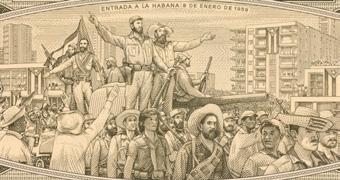
> Truman Doctrine introduced
1950 1953 1947
> May – End of Berlin Blockade
> NATO set up
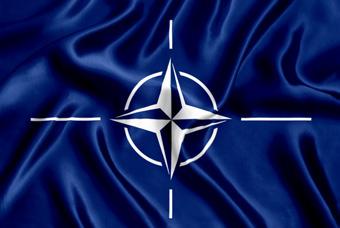
> Stalin dies –replaced by Khruschev
> End of Korean War
1945 1948 SAMPLE
> Warsaw pact set up

> Eisenhower becomes President
> USA sends first military advisers to Vietnam
1949 1952 1954 1959 1955
Topic 26 190
> Cuba becomes communist under Castro
> Bay of pigs invasion takes place in Cuba
> Kennedy meets Khruschev in Vienna
> Russians build Berlin Wall splitting Berlin
1963
> Kennedy assassinated, Johnson president
> Tet offensive – Americans realise war might not be winnable

> Last US troops leave Vietnam
> Gorbachev becomes leader in Russia, attempts to introduce Glasnost and Perestroika
> End of Communism in Russia
> The Cuban Missile crisis takes place
> America sends troops into Vietnam
> Paris peace treaty – ending Vietnam war


> The Berlin wall comes down – End of Communism in Eastern Europe
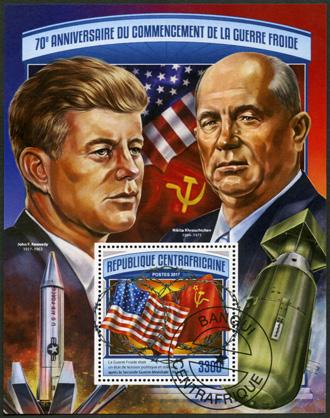
1962
> Reagan becomes US president –increases military spending in attempt to break communism
191 THE COLD WAR
1961
1973
1965 1968 1975 1981 1985 1989 1991SAMPLE
Notes 192 Topic 26
SAMPLE
Morning of&night before
• Before you finish your study, check that you have everything you need ready for the following morning, exam number, pens, etc.
• Don’t sit up cramming, make sure you get a good night’s sleep.
• Eat well before the exam to keep up your stamina.
• Give yourself plenty of time to make sure you arrive on time.
• When you get to school avoid conversations with others about what they have revised, it might onlyincrease your stress.
Keepandcalm succeed
Once in the exam
• Read the paper very carefully.
• Always start with your strongestquestion.
• Make sure to give yourself timeat the end of the exam to re-readover your answers and check them.
SAMPLE
89F Lagan Road, Dublin Industrial Estate, Glasnevin, Dublin 11, D11 F98N, Republic of Ireland. T: ++ 353 1 8081494 - F: ++ 353 1 836 2739 - E: info@4schools.ie - W: www.4schools.ie Junior Cycle Success - History SAMPLE













































